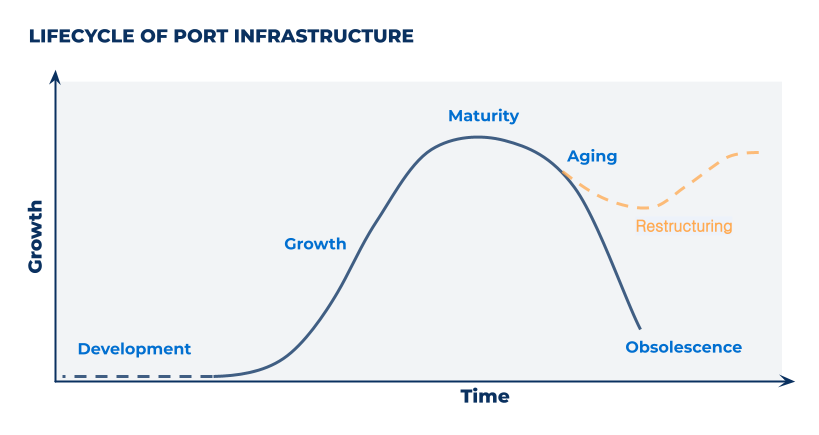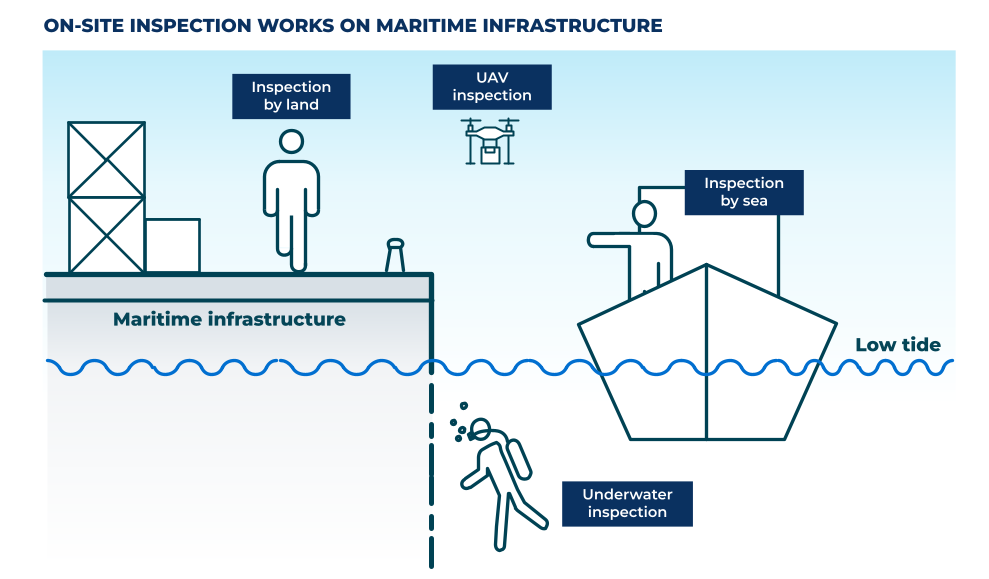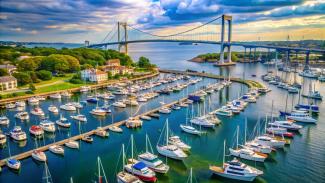Aging maritime infrastructures are those that, after having reached their level of maturity or saturation, are at the end of their design-useful life and, according to their own lifecycle, are about to reach a state of obsolescence unless a process of rehabilitation begins. However, through a partial or total repair process, it is possible not only to extend its lifecycle but also to ensure safe conditions.

Source: ALG based on Ligteringen (2017)
Challenges of aging infrastructure
It is fairly frequent to find maritime infrastructures built more than 50 or 60 years ago and that have considerably exceeded their useful design life. Regardless they have been well maintained or not, when it comes to continuing to use this type of aging infrastructure, there are many uncertainties and concerns.
The use of new technologies applied to the development of materials, the construction, inspection, and maintenance of structures allows to broaden knowledge in comparison to many years ago. As a result, it is necessary to carry out a detailed assessment of this type of infrastructure since its purpose, design loads or its reference regulations under which they were calculated and constructed may have changed.
In many cases, it is necessary to study the possibility of continuing to use the infrastructure as it is, making a progression of possible damage together with a maintenance and protection plan. In other cases, it is possible to carry out repair or reinforcement works in order to adapt the infrastructure to new uses. In all cases, it is necessary to re-calculate it considering the new regulations, load states and environmental considerations (including climate change aspects), along with the possible use that is perused and/or feasible.
Through repair or reinforcement work on the aging infrastructure, useful life can be extended considerably, avoiding leaving it abandoned and unused, or doing a total demolition and reconstruction with its high associated cost.
Main aspects involved
There are three fundamental factors involved in the process of rehabilitation of an aging infrastructure: the future purpose of the infrastructure that is intended and the objective of the works; the current condition of the infrastructure (to be determined through on-site investigation work and additional calculations), and the possible works that can be carried out on the infrastructure for its rehabilitation. Transversal to all is the economic factor, on which the scope of the previous three aspects will depend.

All these three main aspects are intertwined since one can affect the others. It is clear that, depending on the current state of the infrastructure (known after the inspection and analysis process), the remediation work will be adjusted accordingly; however, it may happen that the general state of the structure modifies or redefines its purpose and the work objectives. Likewise, the possible remediation work will depend on the technologies and materials available in the area where the remediation work must be carried out, at a reasonable cost, so the objectives and scope may be modified too.
Objectives and scope of work
In order to achieve the most suitable solution, a clear definition of the objective and needs of the project must be established. In the presence of an aging infrastructure, the scope of work to be carried out varies from project to project, including the strengthening of the existing infrastructure or reframing it for new features. It is common to be required to verify the maximum load capacity of an existing infrastructure, taking into account minor repairs. In other occasions, there may be a project with specific needs and the best way to reinforce the infrastructure at an adequate cost must be analyzed, for example to carry out deepening dredging, place new equipment, or modify the design load.
Within the definition of the work objective, several aspects can be considered such as commercial, technical, economic, political and environmental. In any case, there must be a clear definition of the objective as well as the maximum admissible costs for the rehabilitation of the infrastructure, so that its refurbishment is feasible not only from the technical and environmental point of view but also from the economic and financial ones.
Methodology
The methodology to implement will depend on the objective and purpose of the work and must be adjusted to each project. Nevertheless, there are some steps that most projects have in common, which are listed below. Each step depends on the findings of the preceding step. As the work progresses, changes in the inputs may occur, which could require moving back to a prior step to redefine work conditions and scope.

- Analysis of existing documentation: first, as much historic information as possible concerning the structure should be gathered, including design report (standards of reference, information on material used, operational purposed and function, design life, etc.), drawings, environment information and details of previous inspections. Based on the existing information available, the scope of the on-site works must be determined.
- On-site inspection works: visual inspection of the infrastructure is the first step during an on-site visit, and can be supplemented with photographic inspections methods, which are an effective approach to obtain information from an additional view. During the on-site visit, additional inspection works can be carried out, such as measurement of the geometry of the infrastructure; determination of the position of each piece or structure element; identification, documentation and measurement of cracks, displacements, settlements, inclination and other damages.

Inspection works should be carried out both above and below the water level.
A. Above the water level: inspection by land (walking on the structure, viewing from adjacent land) and by sea (navigation next to the structure with a small craft during low tide) or by aircraft. Additional surveys can be carried out during the on-site inspection such as using of photographic methods with drones and/or other types of Unmanned Aerial Vehicles (UAV).
B. Underwater inspection: usually is hampered by poor visibility and weather conditions (waves and currents). It can be carried out by specialized divers or with specific equipment for infrastructure inspection such as Remotely Operated Vehicles (ROV underwater drones) or Autonomous Underwater Vehicles (USV). - Review of database: together with the existing information and the information gathered during the on-site works, the overall condition of the structure must be analyzed. Additional data acquisition can be planned if justified to further investigate. Possible additional works are shown in the figure below.
A careful selection of the characteristic points of the structure to be tested must be established, since its results will then be extrapolated to the entire structure. The greater the number of points tested, the more certainty there will be about the real state of the structure, but its cost will be increase. For this reason, the balance between the additional cost of each test and the additional information it will provide must be considered.

- Conceptual design and pre-feasibility study: based on the overall condition of the structure and the project needs, different possible solution can be studied. A conceptual design of different alternatives can be carried out, together with a technical and economic pre-feasibility assessment, selecting the most suitable solution through a multi-criteria analysis. Possible solution may include minor repairs, major repair/reinforcement, and partial or total renovation of the infrastructure.
- Modeling and calculation: both the structure and its interaction with the soil can be modeled using finite element software, taking into account the defined service loads, in order to determine its bearing capacity. Furthermore, the global stability of the infrastructure must be also verified. After carrying out the calculations, it is possible that modifications to the solution arise, so it is an iterative process where the solution is adjusted, to arrive at the most convenient one.
The level of detail and certainty of the selected solution will depend on the type and quality of the information available.

































